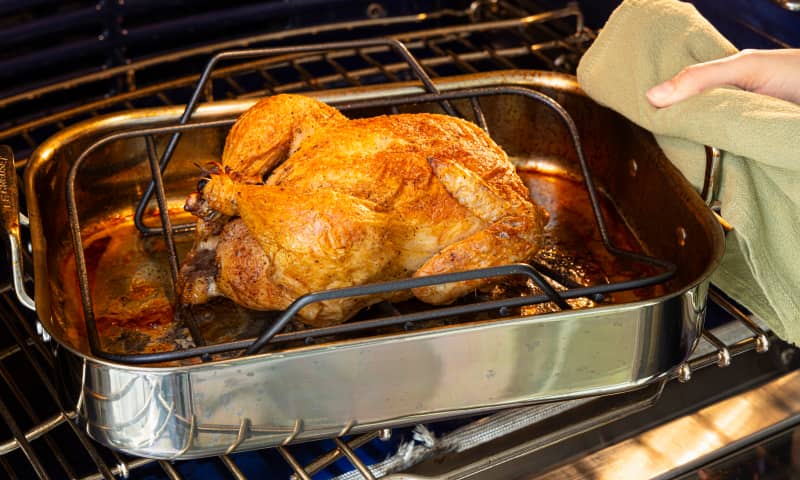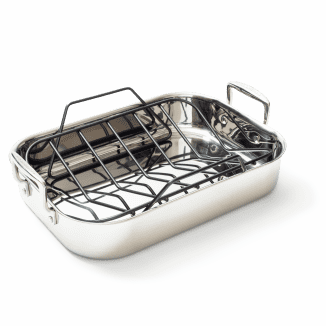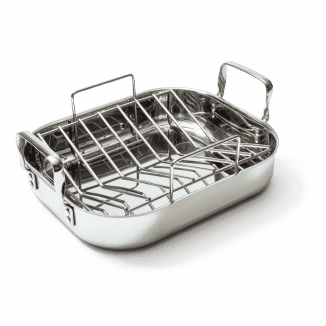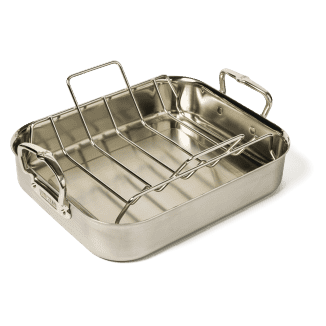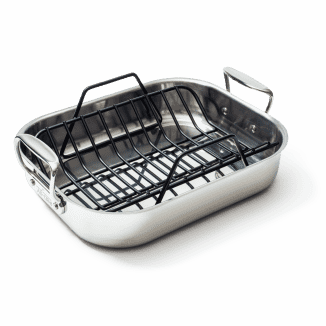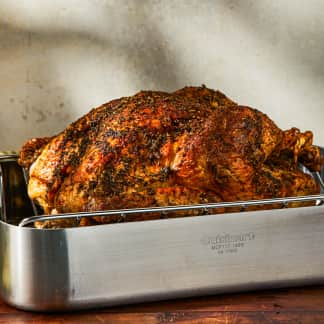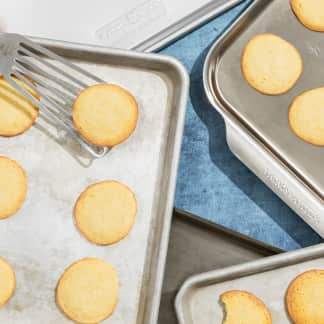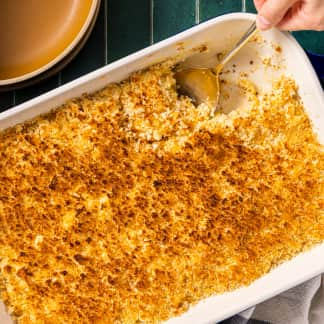The best small roasting pans have flat surfaces for making evenly browned roasts and vegetables and are durable and easy to lift and maneuver. Our favorite is the Le Creuset Stainless Steel Roasting Pan with Rack. It’s pricey, but it made beautiful food and was relatively easy to move around. For a bit less, the Cooks Standard 14" by 12" Stainless Steel Roaster is our Best Buy. It’s a little heavier than our top choice and has unusually high handles that some might find awkward. But it’s a good value for the money. Neither of these models is induction-compatible; for a roasting pan that is, we recommend the Hestan Culinary 14.5-inch Classic Clad Roaster with Rack. It’s a beautiful, durable roasting pan with a snug-fitting rack; we just wish it didn’t have such a large grease trough, which cuts into its usable cooking surface area.

We love a large roasting pan and rack for roasting turkeys and larger cuts of meat. But sometimes we want a more petite version for chickens, vegetables, and smaller cuts of meat. In this review, we cover roasting pans that measure about 14 by 10 inches—this generally results in a small roasting pan that’s about 30 percent smaller than our favorite full-sized models. We’ve tested nearly a dozen of these roasting pans over the years and have some clear conclusions about what makes a good one.
What’s the Best Material for a Small Roasting Pan?
We prefer stainless-steel roasting pans, which perform well and are durable enough to withstand high temperatures without warping but aren’t too heavy to lift. From testing larger roasting pans, we know that thin enamel roasting pans can sometimes warp or get damaged when used under high heat, and nonstick-coated roasting pans can emit toxic fumes under similar conditions. While we love cast-iron cookware in other applications, we find cast-iron roasting pans a bit too heavy to be practical.
As a rule of thumb, we generally prefer stainless-steel cookware that’s considered “fully clad,” meaning that it is built entirely from layers of different metals that are bonded together. In practice, this usually means a layer with aluminum sandwiched between steel, combining the best characteristics of each metal. Unfortunately, it’s hard to find smaller roasting pans that are fully clad, and the ones we’ve tested sometimes have other issues that keep them from taking top billing. Several of our top choices are made from a single, relatively thick layer of stainless steel; we’ve found these to be quite durable and to perform well.
What to Look For
- Tri-Ply or Thick Stainless Steel: These materials were less likely to warp or become damaged when used under or over high heat.
- Moderate Weight: The less a pan weighs, the easier it is to move and maneuver, especially when laden with the extra weight of a roast. While thick stainless-steel pans can be heavy, we preferred those that were slightly less so than others, with a weight of 5 to 7 pounds including the rack. Truly lightweight pans were more likely to warp, and heavier pans were more of a burden to lift.
- Flat Cooking Surface: We liked pans with flat cooking surfaces, as these made it easiest to sear larger pieces of meat or to roast more vegetables evenly. Models with grease troughs around the perimeter of the pan limited the cooking surface area available for searing and were harder to deglaze. They also made it harder to roast vegetables evenly—potato chunks couldn’t sit level across the entire surface, and oil pooled in the troughs instead of extending across the surface of the pan.

- Big Upward-Facing Handles: Big handles measuring at least 4.5 inches across were easier for hands of all sizes to grab, making it easier to transport the pans in and out of the oven. We also preferred handles that faced upward to those that faced outward, as they kept our hands farther from the hot oven walls and made it less likely that we’d accidentally burn ourselves.

- Snug-Fitting Racks: We liked racks that fit closely inside the roasting pans they came with. These kept our roast turkeys and pork loins from shifting around as we moved the pan from stovetop to oven and back.

What to Avoid
- Thin Nonstick-Coated Pans: Pans made from thinner metals are more likely to warp when you heat them on the stovetop to sear meat or deglaze for pan sauces. The nonstick coating also can’t be heated above 500 degrees or else it might emit toxic fumes.
The Tests
- Roast potatoes
- Roast whole chicken and make gravy on stovetop with drippings
- Wash by hand after each test
How We Rated
- Performance: We evaluated the quality of the food produced by each pan and rack.
- Ease of Use: We evaluated the pans and racks on how easy they were to lift, maneuver, and clean.
